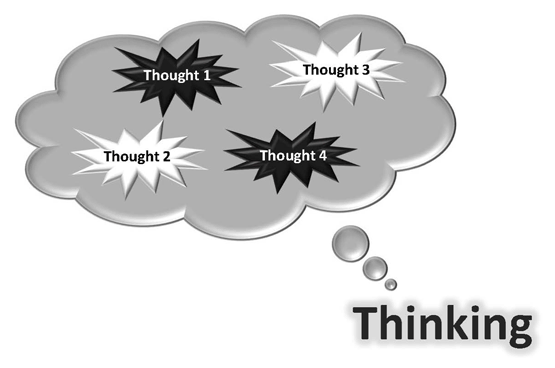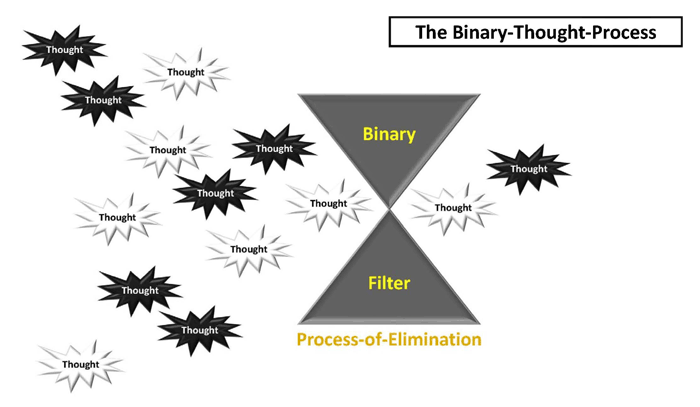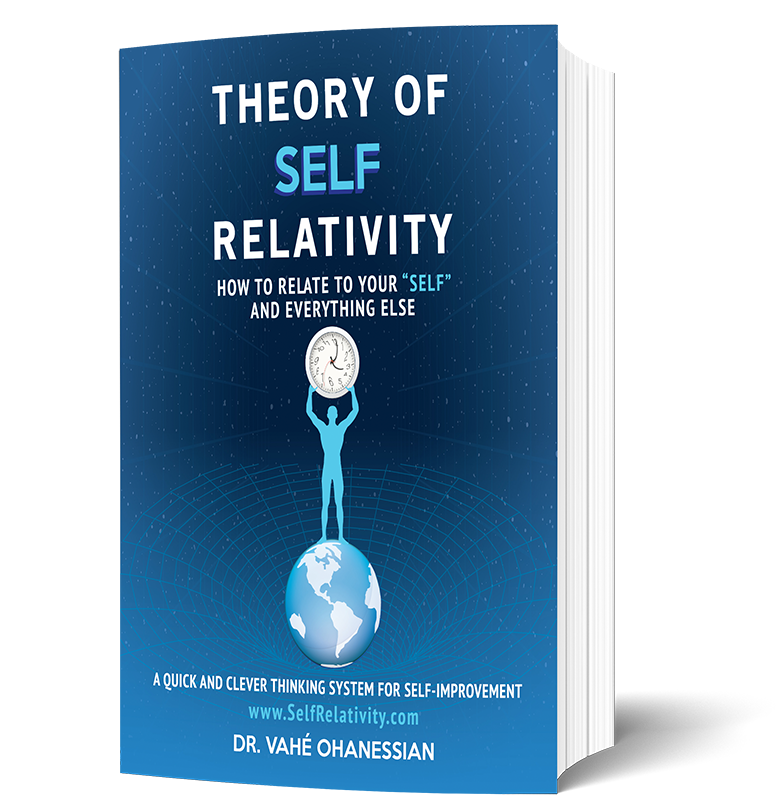Shades of Gray
Our mind is most comfortable and least stressed when it deals with binary choices.
Although it is accepted that one must think in shades-of-gray and not think in blacks or whites; according to Theory of Self-Relativity, the human mind cannot think in a shade-of-gray. Thinking in shades-of-gray is similar to observing and approaching from the outside-in. Just as building the whole building requires to build it one brick and one component at a time; building our thinking also requires building it one thought at a time. The analogy or metaphor that we should think in shades-of-gray is actually an oxymoron. The reason why we cannot think in a shade-of-gray is because gray is not actually a color; gray is a collection of black and white pixels. Thinking in shades-of-gray is to approach our thinking from the outside-in or from the top-down. According to Theory of Self-Relativity we should not think from the top-down, we should think from the bottom-up; therefore, in order to achieve the right shade-of-gray-thinking, we must collect the correct number of individual black and white pixels of individual-thoughts in order to form that correct shade-of-gray. When we approach each individual-thought in a “black and white” or “on and off” or “0 & 1” format; our collective thinking will automatically take on the correct shade-of-gray. Therefore, when we address our individual-thoughts binarily our collective thinking becomes stronger, quicker and cleverer.
Our thinking-system is a collection of all of our individual-thoughts. Instead of thinking in a shade-of-gray, when we learn to address each thought in a black or white format; our thinking will take on the right shade-of-gray. Additionally, as we color each new thought in a black or white format; the correct shade-of-gray will dynamically adjust to the collection of its black and white individual-thought components at any given moment. Therefore, the shade-of-gray associated with our thinking changes continuously depending on the number of individual black and white thoughts that we hold at any given moment.
Since everything is dynamic and everything changes therefore our thinking-system should also be dynamic and should be changing continuously which means we should change constantly and continuously. This is why Theory of Self-Relativity recommends;
In order to change and to improve we must remain unbiased and adaptable.
Although the analogy of black and white makes understanding our thought-process easier; Theory of Self-Relativity’s analogy to black and white is to simplify the understanding that we should binarily resolve or dismiss (on or off) each individual-thought. As discussed, majority of our thoughts are unnecessary and nonfactual therefore by attending to each thought and by accepting (keeping) or dismissing (eliminating) these individual-thoughts, we will then be left with only the right number of applicable-thoughts in our thinking-system. Consequently, by uncluttering our thinking-system from unnecessary and wasteful thoughts, this binary-filtering of our individual-thoughts will release ample available processing and storage space in our mind.
Since our “thinking” is the collection of all of our “individual-thoughts” hence our individual-thoughts are the elementary, fundamental and structural building-blocks of our total thinking. Therefore, in order for “the structure” or “the building” of our thinking to be sound and stable, its structural-foundation and its building-blocks must individually be solid and flawless. Additionally, and as discussed, our thinking-system must be in shades-of-gray and it should be able to dynamically fluctuate its grayscale within unlimited shades-of-grayness. However, we must think individual-thoughts in blacks or whites in order to achieve the right shade-of-gray. This is why binary-evaluation and binary-approach must only occur at the most fundamental and basic level where only two choices exist; not when two choices can be selectively chosen from multiple possibilities. Binary-analysis should only happen where there are no more than two-choices available hence at the fundamental level of individual-thoughts a thought could either be factual or nonfactual because only one form of fact per situation exists.
Thinking is a combination of multiple-thoughts, hence thinking cannot and should not be binary; however individual-thoughts which make up our collective thinking-system could and should be evaluated in a binary-format. Contrary to popular belief we cannot think in metaphorical shades-of-gray because a grayscale is the resulting combination of its black and white components or pixels. Furthermore, black or white themselves could actually be considered as the extreme shades-of-gray. Hence by accumulating the right number of individual-thoughts in the metaphorical shade of black or white we can automatically reach the proper metaphorical shade-of-gray-thinking. Additionally, color gray is the result of the combination of its black and white pixels and the gray shade can be intensified or lessened by adjusting the number of its black and white pixels.

Same holds true for our thoughts as we should accept our factual thoughts and we should dismiss our nonfactual ones. Our thinking should always be in the metaphorical shades-of-gray which is the result of the combination of its metaphorical black and white individual-thoughts. To best understand the difference between our individual-thoughts and our thinking, consider each individual-thought as being analogous to an individual black or white pixel. Hence the collection of our metaphorical black and white individual-thoughts creates our proper metaphorical gray shade of thinking.

Thinking in the shades-of-gray is a metaphorical term used in psychology in order to demonstrate that our thinking should be flexible and malleable but not rigid; however, in order to have flexibility of thinking we cannot approach it from the macro or collective-thinking level; we must approach it from the micro or individual-thought level. To think in the shade-of-gray means to try to think from the top down or to think from the outside in; it is impossible to think in shades-of-gray. We cannot choose the right gray shade by thinking gray however, by learning to individually address each thought in black or white, the correct shade-of-gray will automatically appear.
Our thoughts change continuously as we think new individual-thoughts hence the gray shade of our thinking changes as we add, keep or eliminate these individual-thoughts which occupy our mind. Since our individual-thoughts appear, disappear and change therefore the collective gray shade of our thinking also changes. This is why trying to think in shades-of-gray is an impossible task because to try to think in a shade-of-gray, we will be endlessly chasing the dynamic and changing pattern of our individual-thoughts that pop into and out of existence. However, when we become mindful and thoughtful of our individual-thoughts we can then keep or eliminate each individual-thought based on its factual-value.
A common example of binary-thinking or black and white thinking is when someone considers another person as all good or all bad or if they would suddenly classify a person as all good or all bad based on a single interaction. For example, we have a friend that we have known for a while and we play basketball together every week. After the game we sometimes go to get ice cream but he never pays for the ice cream. Despite having a close personal relationship together, we begin to resent the fact that he never pays for the ice cream and this thought of him not paying for the ice cream begins to build up in our mind as a dominant image of his character compared to his other good qualities. The next time that we go to have ice cream after the game, once again he does not offer to pay for the ice cream. After we leave, we become so upset that he didn’t pay for the ice cream that we ignore his future invitations to go play basketball and we cut our friendship with him.
This all or none example of how we handled our relationship with our friend is a representation of black and white thinking. Although our concern was based on an individual-thought regarding him not buying ice cream, instead of us evaluating that thought individually and deciding what to do with it, we decided collectively to make a decision about our relationship with him. The correct way of processing would’ve been for us to evaluate the basic thought of him not paying for ice cream and to either bring it up to his attention by taking an action or to abstain from taking an action because we decided that paying for the ice cream is not an important issue compared to all the other interactions that we have together. By evaluating the fact that he is being cheap and not paying for ice cream, we could’ve performed an individual-thought-process in a black or white binary-format and adjusted the resulting gray shade of our relationship with him according to that single thought. In this case, the facts indicated that he was being cheap but the facts didn’t indicate that he was not worthy of having a relationship with.
The right shade-of-gray-thinking or factual-thinking is best achieved by only keeping its underlying factual-thoughts and by eliminating the nonfactual ones; hence the remaining thoughts will comprise our factual-thinking-system. Theory of Self-Relativity has termed this binary way of evaluating our individual-thoughts as the “Binary-Thought-Process” or the “Binary-Approach.” The binary-thought-processing enables us to address each individual-thought as metaphorically black or white or in reality as factual or nonfactual. This individual-thought-processing based on each individual-thought’s factual-value enables our thinking-system to take on the right shade-of-gray or to become factual. The binary-thought-process uses the “Binary-Filter” to select the metaphorically black or white (factual or nonfactual) thoughts that we should keep or eliminate. The binary-filter itself is a metaphorical name given by Theory of Self-Relativity to our immaterial-mental-activities of analyzing and filtering out our individual-thoughts.
Since our thinking is a collection of our thoughts and our thoughts are the building-blocks of our collective-thinking; when we learn to engage in the binary-thought-process we use our binary-filter to implement the “process-of-elimination.” By using the binary-filter alongside the process-of-elimination, we filter our individual-thoughts that make up our collective-thinking-system. By evaluating our individual-thoughts for their factual-value, we can then use our binary-filter to filter-out and eliminate (dismiss) our nonfactual-thoughts and to filter-through or keep (accept) our factual ones. By filtering through each individual-thought in a binary-format and by eliminating the unnecessary and nonfactual thoughts, we can filter in only the necessary thoughts that really matter. These filtered-in thoughts which have not been eliminated will give us the proper final format of our collective-thinking. The process-of-elimination is a commonly used practice in science and problem-solving in order to filter through the best answers and best choices and solutions for a situation.
Theory of Self-Relativity defines the “Process-of-Elimination” as “a mental and logical process that allows us to keep the best-available, the best-applicable or the most-relevant of existing choices by removing or eliminating all others.”

The process-of-elimination allows for the best available choice to remain and the rest to be discarded. Same principle applies to our thoughts. The binary-thought-process uses the process-of-elimination through the binary-filter in order to enable us to eliminate our cluttering and nonfactual-thoughts and to only keep our factual-thoughts. By evaluating and filtering out our nonfactual-thoughts, we then only keep the factual-thoughts which are based on the way reality is and not based on how we want reality to be.
As Aristotle stated; “It is the mark of an educated mind to be able to entertain a thought without accepting it.”
The process-of-elimination removes and eliminates clutter by bringing the focus to only thoughts which have factual-basis. Since the process-of-elimination is a mental and thought-based activity therefore the binary-thought-process itself requires mindfulness and thoughtfulness in order to achieve the most efficient and high-quality retention of factual-thoughts. This is why Theory of Self-Relativity insists that mindfulness alone cannot be effective and it must be followed by thoughtfulness. Theory of Self-Relativity refers to this combination of thoughtfulness and binary-thought-process as our “Thought-Management” skill.
Theory of Self-Relativity defines “Thought-Management” as “the process to manage thoughts by eliminating nonfactual-thoughts and only retaining factual-thoughts.”

